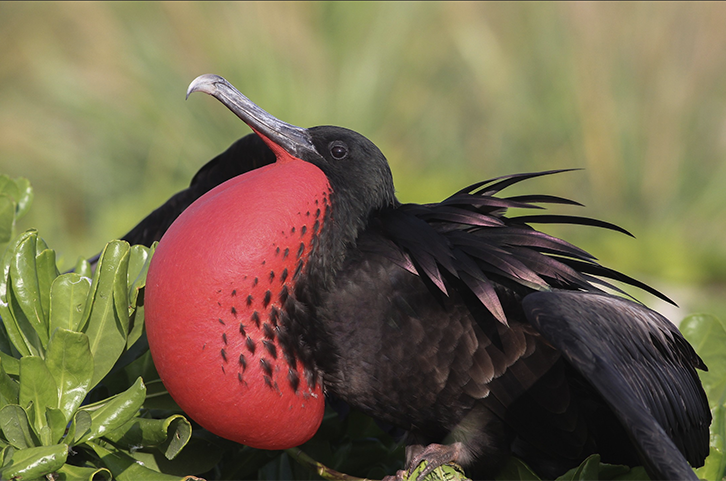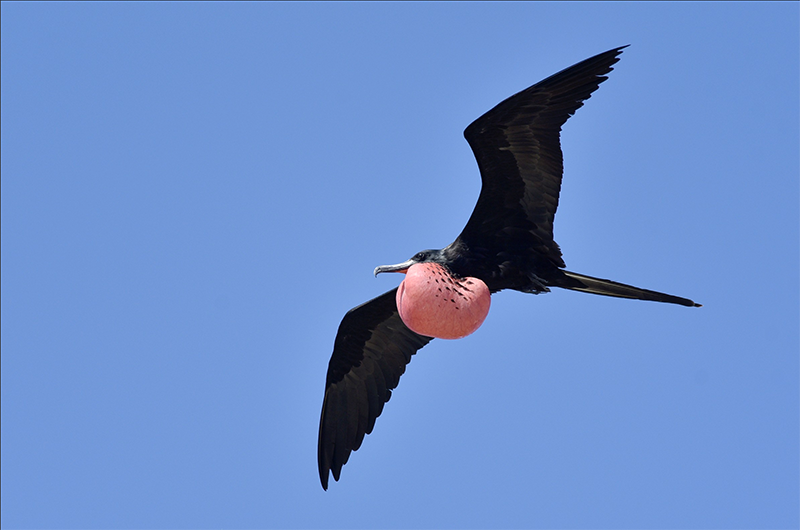Frigatebirds
| Order: SULIFORMES - Family: FREGATIDAE |
| 5 Species currently existing - 2 in region |
Frigatebirds, also known simply as frigates, are a group of seabirds belonging to the family Fregatidae. These birds are known for their distinctive appearance, remarkable flying skills, and unique behavior. Here are some key points about frigatebirds: Read in Spanish
Physical Characteristics
Large Size: Frigatebirds are large seabirds with long, slender wings, making them exceptional flyers. They have a wingspan that can exceed 7 feet in some species.
Distinctive Silhouette: Frigatebirds have a unique silhouette in flight, with long, pointed wings and deeply forked tails. They are known for their effortless soaring and aerial agility.
Sexual Dimorphism: Male and female frigatebirds exhibit sexual dimorphism in plumage. Males typically have black plumage with a characteristic red throat pouch that they inflate during courtship displays, while females have white underparts.
Habitat and Range
Tropical and Subtropical Oceans: Frigatebirds are primarily found in tropical and subtropical regions around the world, where they frequent coastal areas and open seas.
Roaming Over Large Distances: These birds are known for their ability to cover vast distances over the ocean in search of food, aided by their exceptional flight capabilities.
Feeding Behavior
Pirate Birds: Frigatebirds are also known as "pirate birds" because they have a unique feeding strategy. They are skilled aerial kleptoparasites, meaning they harass other seabirds in flight to steal their food.
Fish and Squid Predators: Frigatebirds primarily feed on fish and squid, which they catch by skimming the ocean surface or plunge diving from the air. They may also feed on scraps and stolen prey from other birds.
Behavior and Reproduction
Colonial Nesters: Frigatebirds often nest in colonies on remote islands or coastal cliffs. They build platform nests using sticks and other materials, with some species nesting in trees.
Extended Parental Care: Frigatebirds have a prolonged nesting period compared to other seabirds. Both parents participate in incubating the eggs and caring for the chicks, which have a relatively long fledging period.
Conservation Status
Threats
- Frigatebirds face threats from habitat loss, disturbance at nesting sites, entanglement in fishing gear, and pollution. Climate change and severe weather events can also impact their breeding success.
Conservation Efforts
- Conservation measures for frigatebirds focus on protecting important breeding sites, minimizing human disturbances, and mitigating threats such as plastic pollution and bycatch.
- Research on frigatebird ecology and population trends helps inform conservation strategies to safeguard these iconic seabirds.
Frigatebirds are fascinating seabirds with unique adaptations for life over the open ocean. Their aerial prowess, distinctive appearance, and intriguing behavior make them a captivating species to study and appreciate in their marine habitats.

Great Frigatebird
Fregata minor
Spanish Name: Fragata Alibandeada
Size: 38 in | 97 cm
Habitat: Pacific Coast.
Height: Sea level.
Photo: © Cameron Rutt eBird S29599093 Macaulay Library ML28632541

Magnificent Frigatebird
Fregata magnificens
Spanish Name: Fragate Magnífica
Size: 40 in | 102 cm
Habitat: Atlantic and Pacific Coast.
Height: Sea level
Photo: © Daniel Irons eBird S64435232 Macaulay Library ML238577491

